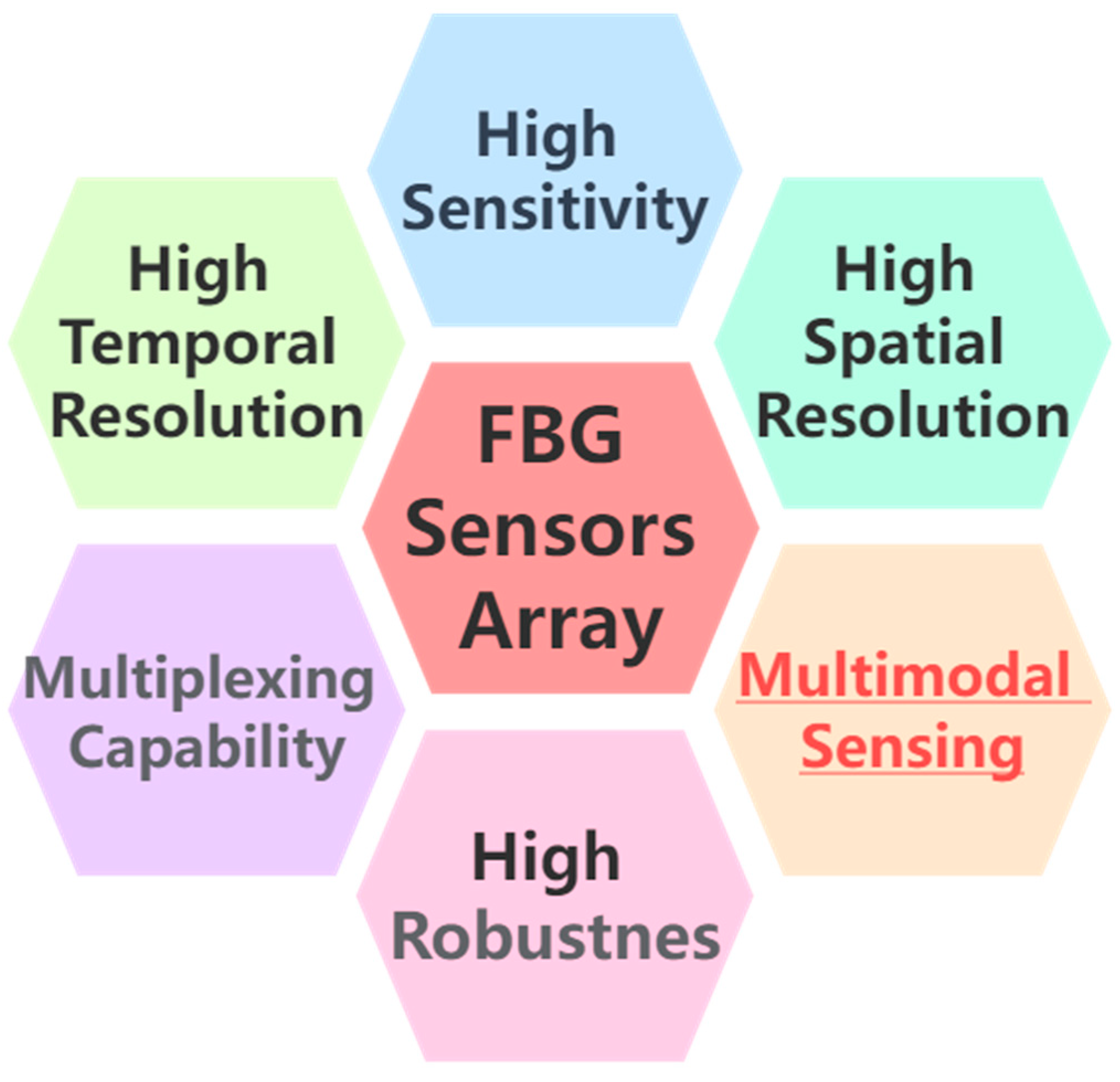Taking Flow Characterization to New Heights by Fiber Bragg Gratings Array
1. Introduction
2. Discussion
3. Conclusions
Acknowledgments
Conflicts of Interest
References
- Zhang, D.; Deng, J.; Xu, Z.; Mori, M. Editorial: Thermal Hydraulics and Safety Analysis in Generation-IV Reactors. Front. Energy Res. 2021, 9, 670412. [Google Scholar] [CrossRef]
- Wakabayashi, G.; Yamada, T.; Endo, T.; Pyeon, C.H. Nuclear Instrumentation. In Introduction to Nuclear Reactor Experiments, 1st ed.; Springer: Singapore, 2023; Volume 5, pp. 137–152. [Google Scholar]
- Rohacs, D.; Yasar, O.; Kale, U.; Ekici, S.; Yalcin, E.; Midilli, A.; Karakoc, T.H. Past and current components-based detailing of particle image velocimetry: A comprehensive review. Heliyon 2023, 9, 14404. [Google Scholar] [CrossRef] [PubMed]
- Tien, T.M.; Huang, C.J.; Lee, C.H.; Liu, K.W. Fiber-Optic Probe Array for Measuring Spatial Distributions of Air Volume Fractions in Bubbly Flows. Sensors 2023, 23, 1222. [Google Scholar] [CrossRef] [PubMed]
- Hampel, U.; Barthel, F.; Bieberle, A.; Bieberle, M.; Boden, S.; Franz, R.; Kipping, M.N.; Köhler, S.T. Tomographic imaging of two-phase flow. Int. J. Adv. Nucl. React. Des. Technol. 2020, 2, 86–92. [Google Scholar] [CrossRef]
- Fan, J.; Wang, F. Review of ultrasonic measurement methods for two-phase flow. Rev. Sci. Instrum. 2021, 92, 091502. [Google Scholar] [CrossRef] [PubMed]
- Tompkins, C.; Prasser, H.M.; Corradini, M. Wire-mesh sensors: A review of methods and uncertainty in multiphase flows relative to other measurement techniques. Nucl. Eng. Des. 2018, 337, 205–220. [Google Scholar] [CrossRef]
- Hill, K.O. Photosensitivity in optical fiber waveguides: From discovery to commercialization. IEEE J. Sel. Top. Quantum Electron. 2000, 6, 1186–1189. [Google Scholar] [CrossRef]
- Dmitriev, A.A.; Gribaev, A.I.; Varzhel, S.V.; Konnov, K.A.; Motorin, E.A. High-performance fiber Bragg gratings arrays inscription method. Opt. Fiber Technol. 2021, 63, 102508. [Google Scholar] [CrossRef]
- Allil, A.S.; Dutra, F.S.; Dante, A.; Carvalho, C.C.; Allil, R.C.S.B.; Werneck, M.M. FBG-Based Sensor Applied to Flow Rate Measurements. IEEE Trans. Instrum. Meas. 2021, 70, 7000608. [Google Scholar] [CrossRef]
- Gouvêa, P.M.P.; Medeiros, K.A.R.; Ribeiro, A.S.; Barbosa, C.R.H.; Almeida, J.R.M.; Braga, A.M.B. Non-Intrusive Fluid Flow Measurement by FBG Sensing of Flow-Induced Vibrations. In Proceedings of the Advanced Photonics, Zurich, Switzerland, 2–5 July 2018. [Google Scholar]
- Zamarreño, C.R.; Martelli, C.; Baroncini, V.H.V.; Santos, E.N.; Silva, M.J.; Morales, R.E.M.; Matias, I.R.; Arregui, F.J. Two-Phase Flow Imaging by means of an 8 × 8 Optical Fiber Bragg Grating Grid. In Proceedings of the Advanced Photonics, Barcelona, Spain, 27–31 July 2014. [Google Scholar]
- Luo, C.; Wang, H.; Zhang, D.; Zhao, Z.; Li, Y.; Li, C.; Liang, K. Analytical Evaluation and Experiment of the Dynamic Characteristics of Double-Thimble-Type Fiber Bragg Grating Temperature Sensors. Micromachines 2021, 12, 16. [Google Scholar] [CrossRef] [PubMed]
- Thureja, P.; Sokhoyan, R.; Hail, C.U.; Sisler, J.; Foley, M.; Grajower, M.Y.; Atwater, H.A. Toward a universal metasurface for optical imaging, communication, and computation. Nanophotonics 2022, 11, 3745–3768. [Google Scholar] [CrossRef]
- An, S.; Zheng, B.; Julian, M.; Williams, C.; Tang, H.; Gu, T.; Zhang, H.; Kim, H.J.; Hu, J. Deep neural network enabled active metasurface embedded design. Nanophotonics 2022, 11, 4149–4158. [Google Scholar] [CrossRef]

| Technology | Advantages | Limitations | References |
|---|---|---|---|
| Particle image velocimetry | Non-intrusive for cross section | Optical access required for test region; fluid seeded with micro-particles required; high-power laser needed for reducing size of tracer particles; Suitable for low void-fraction. | [3] |
| Optical probes array | Simple and cheap | Accuracy sensitive to signal being measured; particularly sensitive to low void-fraction small-bubble cases. | [4] |
| X-ray tomography | Non-intrusive for cross section | Small field of view; radiation concern; expensive. | [5] |
| Optical tomography | Non-intrusive for | Limited by light source and detectors; limited penetration depth. | [5] |
| cross section | |||
| Ultrasonic methods | Non-intrusive for cross section | Large-seeded particles required; resolution limited by separating signals from seeds and bubbles; suitable for low void-fraction. | [6] |
| Wire-mesh sensor | High temporal and spatial resolutions | Slightly intrusive for cross section. | [7] |
Disclaimer/Publisher’s Note: The statements, opinions and data contained in all publications are solely those of the individual author(s) and contributor(s) and not of MDPI and/or the editor(s). MDPI and/or the editor(s) disclaim responsibility for any injury to people or property resulting from any ideas, methods, instructions or products referred to in the content. |
© 2023 by the author. Licensee MDPI, Basel, Switzerland. This article is an open access article distributed under the terms and conditions of the Creative Commons Attribution (CC BY) license (https://creativecommons.org/licenses/by/4.0/).
Share and Cite
Li, J. Taking Flow Characterization to New Heights by Fiber Bragg Gratings Array. Energies 2023, 16, 4218. https://doi.org/10.3390/en16104218
Li J. Taking Flow Characterization to New Heights by Fiber Bragg Gratings Array. Energies. 2023; 16(10):4218. https://doi.org/10.3390/en16104218
Chicago/Turabian StyleLi, Jinfeng. 2023. "Taking Flow Characterization to New Heights by Fiber Bragg Gratings Array" Energies 16, no. 10: 4218. https://doi.org/10.3390/en16104218
APA StyleLi, J. (2023). Taking Flow Characterization to New Heights by Fiber Bragg Gratings Array. Energies, 16(10), 4218. https://doi.org/10.3390/en16104218




